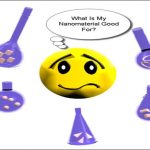Welcome to one of our guest columns, where active researchers can share their views on topics relevant to materials science. In this Today in Nano Guest Series, Professor Geoffrey Ozin from the University of Toronto shares his thoughts on a question that many of today’s scientists are asking. More articles from this guest column can be found at http://nanochemistry.materialsviews.com.
 Whatever happened to curiosity-driven research aimed at the creation of fundamental knowledge without the need for immediate application?
Whatever happened to curiosity-driven research aimed at the creation of fundamental knowledge without the need for immediate application?
Throughout the history of science, many of the discoveries which have proven to be the most important and influential for humanity have arisen out of nothing more than a scientist pursuing his curiosity. Electricity, X-rays, lasers, and semiconductors are classic examples of this and pretty well every great scientific discovery would not have been made if the research had been driven by applications and economic impact, which tend to encourage unoriginal research and reduce the likelihood of discovering things that did not exist before, the very essence of research.
Nowadays, in the area of materials research, however, scientists have to pin applications on their materials which aren’t ready for them. It’s not enough to just study an interesting material – now you must put it into a solar cell (and probably not a very good one because it takes years to develop these things) or claim that it is good for ‘drug delivery’ or a ‘sensor’ or a ‘battery’ or a ‘white light emitting diode’.
Although the taxpayers who fund our research naturally deserve to see it applied to a problem that affects them, we often spend too much time on trying to dress up science which is at a very early stage and from which it will realistically take many years for practical applications to come, as something which will save the world next week. Just come up with a nice new nanomaterial? You’ll be making 70% efficient ‘third-generation’ solar cells from it by the end of the year, $1bn production in two years and climbing exponentially. You’ll have simultaneously averted climate catastrophe and saved your country’s floundering economy. At the very least you’ll be feathering your research treasure chest!
When I was beginning my academic career as a young assistant professor at the University of Toronto in 1969 my research was directed towards pure, unadulterated knowledge generation geared towards making an original and important contribution in my chosen area of interest. My work at the time involved experimental and theoretical studies of nucleation and growth of ligand-free metal clusters from the atom up and how these metal clusters interacted with ligands.
The goal of this work was to throw light on the transition of metal atoms to metal clusters to bulk metal and to explore localized bonding models of chemisorption of the aforementioned ligands on metal surfaces, work inspired by the challenge at that time of trying to understand the basic science that underpins metal cluster catalysis, and as it turns out these were embryonic steps in the field of bottom-up nanomaterials.
Today it is virtually guaranteed that any attempt to have fundamental materials research published in a top-rank peer-reviewed journal will result in you being told by referees and editors that while your results are hopefully of high scientific quality you have not shown practical utility and that unless this is demonstrated the work is not acceptable for publication in our journal and you should try a more specialized one. How many scientists striving to do basic research in the field of (nano)materials have been faced with this dilemma?
Perhaps my experiences over a four-decade career can throw some light on the origin of this change from ideas-driven research to one progressively and possibly irreversibly based on application.
On arriving at the University of Toronto to begin a program of research and teaching in materials chemistry in the chemistry department I was faced with what seemed like an insurmountable problem. Pretty well all materials research in this era was conducted in materials science and engineering departments. This had always been the tradition and I soon realized that trying to convince my materials science and engineering colleagues otherwise was going to be met with powerful opposition and to persuade my colleagues in chemistry that I was a worthy partner who belonged in their department was going to be a struggle.
My main argument was that new classes of materials, and not ones based on incremental improvements of existing materials, are invented by chemists who are trained to devise synthetic pathways to novel compositions of matter. On these grounds after much debate my case was accepted by materials science and engineering, and I initiated a materials chemistry program of research and teaching for the first time in the chemistry department at the University of Toronto in the early seventies.
This is how my materials chemistry and nanochemistry activities began, and these were the heydays of curiosity-driven research in the field mainly driven by synthetic inorganic, organometallic and polymer chemists transitioning their careers to this emerging and exciting new field, and as a result funding began to flow from granting agencies worldwide to power basic research efforts.
As the promise of the cornucopia of new materials and nanomaterials being produced by synthetic chemists became clear, a number of important changes transpired that led people to wonder and to ask: ‘what are all these new (nano)materials going to be good for?’
First, granting agencies, presumably influenced by government policy and pressure from industrial leaders began to demand relevance as a prerequisite for successful funding of materials and nanomaterials research. Academic researchers who were focusing on curiosity-driven scientific questions were now being coerced to think beyond synthesis, structure, and property to include utility, which was often not their strength.
Second, as a result of this change of focus from ideas to application in (nano)materials chemistry, practitioners of the art sought collaborations with physics and materials engineering colleagues, very few of whom were, at the time, prepared to step outside of their specialized area of expertise and take a risk working with chemists on their new-fangled (nano)materials to try to help them determine what they might be good for and in the process helping them survive the pressure from granting agencies who had imposed this requirement on funding.
This in my view is where the interdisciplinary approach to (nano)materials chemistry that flourishes today originated, and this is one thing that we can be thankful for when it comes to the change in emphasis of research – in order to show potential applications, even if they may not be quite so realistic as is frequently claimed, we must seek out broader collaborations and expand our networks beyond the confines of our own labs.
Initially very few materials physicists and engineers bought into this thrust towards collaborative teamwork with chemists, but as interest grew in the profusion of new (nano)materials with a plethora of novel, important and potentially technologically relevant breakthroughs, critical mass was achieved, and the field changed its character forever from one that was powered mainly by curiosity-driven basic science to one directed by applications and technological consequence.
I suppose we should not be surprised that this change has occurred because the materials physics and engineering community eventually recognized the potential of this new wave of (nano)materials being produced by chemists, and all those brave collaborators who believed in the revolution in (nano)materials chemistry research refocused their attention on non-traditional materials rather than the materials that had underpinned their field for more than a century and had provided them with the building blocks for engineering the needs of the human race.
There is no going back to just pure (nano)materials research and nowadays your pet (nano)material has to be presented as having a potential application. You can see this first-hand in the way the content of the top (nano)materials science journals has transformed from a (nano)chemistry approach to nanomaterials to a (nano)engineering focus heavily driven by practical utility. This philosophy is also being promulgated by funding agencies with government and industry support leaving little space for a chemistry approach to nanomaterials to maneuver.
I am not going to reiterate on my recently published views on “Nanochemistry – What Is Next?” (Ozin and Cademartiri, Small 2009, 5, 1240-1244) and “From Ideas to Innovation – Nanochemistry a Case Study” (Ozin and Cademartiri, Small 2011, 7, 49-54), other than to say that without great patience, dogged perseverance and sound investment in the future of curiosity-driven (nano)materials research, the natural progression from the breakthrough to the new products will be in great jeopardy. It is not in anybody’s interest to try to control the unpredictable fruits of fundamental research in the exciting area of (nano)materials chemistry!
In my opinion it’s not all about whether your favorite (nano)material is good for a better performing lithium ion battery, a hydrogen storage reservoir, a dye-sensitized solar cell, a water-splitting or carbon-dioxide-recycling photocatalyst, a full-color display, a white light-emitting diode, a photodetector, a drug delivery or biomedical imaging system and so forth, which everybody in the world is working on to satisfy government and industry, but rather is it interesting in a way that others aren’t? Does it teach us something new and unexpected? If you want it to be the great idea which changes the world, then surely you’re aiming for application, which seems contrary to the point!


















